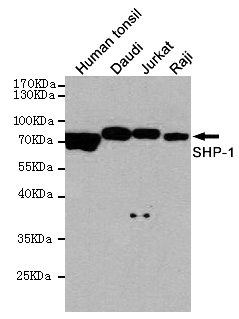SHP-1 Antibody
Purified Mouse Monoclonal Antibody (Mab)
- 产品详情
- 实验流程
- 背景知识
Application
| WB |
|---|---|
| Primary Accession | P29350 |
| Reactivity | Human |
| Host | Mouse |
| Clonality | Monoclonal |
| Isotype | IgG2a |
| Calculated MW | 67561 Da |
| Gene ID | 5777 |
|---|---|
| Other Names | 70 kda SHP1L protein ; 70Z-SHP ; EC 3.1.3.48 ; HCP ; HCPH ; Hematopoietic cell phosphatase ; Hematopoietic cell protein tyrosine phosphatase ; Hematopoietic cell protein-tyrosine phosphatase ; HPTP1C ; Protein tyrosine phosphatase 1C ; Protein tyrosine phosphatase non receptor type 6 ; Protein tyrosine phosphatase SHP1 ; Protein-tyrosine phosphatase 1C ; protein-tyrosine phosphatase SHP 1 ; Protein-tyrosine phosphatase SHP-1 ; PTN6_HUMAN ; PTP 1C ; PTP-1C ; PTP1C ; PTPN6 ; SH PTP 1 ; SH PTP1 ; SH-PTP1 ; SHP 1 ; SHP 1L ; SHP1 ; SHP1L ; tyrosine protein phosphatase non receptor type 6 ; Tyrosine-protein phosphatase non-receptor type 6. |
| Dilution | WB~~1:1000 |
| Format | Liquid in PBS containing 50% glycerol, 0.5% BSA and 0.02% sodium azide, pH 7.3. |
| Storage | Store at 4°C short term. Aliquot and store at -20°C long term. Avoid freeze/thaw cycles. |
| Name | PTPN6 |
|---|---|
| Synonyms | HCP, PTP1C |
| Function | Tyrosine phosphatase enzyme that plays important roles in controlling immune signaling pathways and fundamental physiological processes such as hematopoiesis (PubMed:14739280, PubMed:29925997). Dephosphorylates and negatively regulate several receptor tyrosine kinases (RTKs) such as EGFR, PDGFR and FGFR, thereby modulating their signaling activities (PubMed:21258366, PubMed:9733788). When recruited to immunoreceptor tyrosine-based inhibitory motif (ITIM)-containing receptors such as immunoglobulin-like transcript 2/LILRB1, programmed cell death protein 1/PDCD1, CD3D, CD22, CLEC12A and other receptors involved in immune regulation, initiates their dephosphorylation and subsequently inhibits downstream signaling events (PubMed:11907092, PubMed:14739280, PubMed:37932456, PubMed:38166031). Modulates the signaling of several cytokine receptors including IL-4 receptor (PubMed:9065461). Additionally, targets multiple cytoplasmic signaling molecules including STING1, LCK or STAT1 among others involved in diverse cellular processes including modulation of T-cell activation or cGAS-STING signaling (PubMed:34811497, PubMed:38532423). Within the nucleus, negatively regulates the activity of some transcription factors such as NFAT5 via direct dephosphorylation. Also acts as a key transcriptional regulator of hepatic gluconeogenesis by controlling recruitment of RNA polymerase II to the PCK1 promoter together with STAT5A (PubMed:37595871). |
| Cellular Location | Cytoplasm. Nucleus Note=In neurons, translocates into the nucleus after treatment with angiotensin II (By similarity). Shuttles between the cytoplasm and nucleus via its association with PDPK1. |
| Tissue Location | Isoform 1 is expressed in hematopoietic cells. Isoform 2 is expressed in non-hematopoietic cells |
For Research Use Only. Not For Use In Diagnostic Procedures.
Provided below are standard protocols that you may find useful for product applications.
BACKGROUND
Modulates signaling by tyrosine phosphorylated cell surface receptors such as KIT and the EGF receptor/EGFR. The SH2 regions may interact with other cellular components to modulate its own phosphatase activity against interacting substrates. Together with MTUS1, induces UBE2V2 expression upon angiotensin II stimulation. Plays a key role in hematopoiesis.
REFERENCES
Yi T.,et al.Mol. Cell. Biol. 12:836-846(1992).
Shen S.H.,et al.Nature 352:736-739(1991).
Shen S.H.,et al.Nature 353:868-868(1991).
Plutzky J.,et al.Proc. Natl. Acad. Sci. U.S.A. 89:1123-1127(1992).
Banville D.,et al.Genomics 27:165-173(1995).
终于等到您。ABCEPTA(百远生物)抗体产品。
点击下方“我要评价 ”按钮提交您的反馈信息,您的反馈和评价是我们最宝贵的财富之一,
我们将在1-3个工作日内处理您的反馈信息。
如有疑问,联系:0512-88856768 tech-china@abcepta.com.























 癌症的基本特征包括细胞增殖、血管生成、迁移、凋亡逃避机制和细胞永生等。找到癌症发生过程中这些通路的关键标记物和对应的抗体用于检测至关重要。
癌症的基本特征包括细胞增殖、血管生成、迁移、凋亡逃避机制和细胞永生等。找到癌症发生过程中这些通路的关键标记物和对应的抗体用于检测至关重要。 为您推荐一个泛素化位点预测神器——泛素化分析工具,可以为您的蛋白的泛素化位点作出预测和评分。
为您推荐一个泛素化位点预测神器——泛素化分析工具,可以为您的蛋白的泛素化位点作出预测和评分。 细胞自噬受体图形绘图工具为你的蛋白的细胞受体结合位点作出预测和评分,识别结合到自噬通路中的蛋白是非常重要的,便于让我们理解自噬在正常生理、病理过程中的作用,如发育、细胞分化、神经退化性疾病、压力条件下、感染和癌症。
细胞自噬受体图形绘图工具为你的蛋白的细胞受体结合位点作出预测和评分,识别结合到自噬通路中的蛋白是非常重要的,便于让我们理解自噬在正常生理、病理过程中的作用,如发育、细胞分化、神经退化性疾病、压力条件下、感染和癌症。






